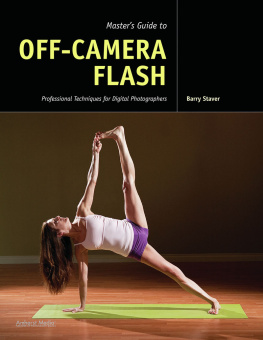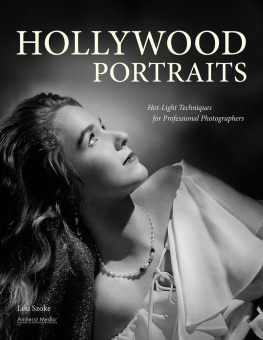About the Author

Barry Staver photographs people, designing highly effective corporate photography and dramatic portraiture. His storytelling approach is built on decades of experience as a photographic journalist on assignment for some of the worlds greatest magazines, including People, Sports Illustrated, and Time. Barry serves on the Professional Advisory Board at the Art Institute of Colorado and is honored to share the Pulitzer Prize in Journalism.
Copyright 2012 by Barry Staver.
All rights reserved.
All photographs by the author unless otherwise noted.
Published by:
Amherst Media, Inc.
P.O. Box 586
Buffalo, N.Y. 14226
Fax: 716-874-4508
www.AmherstMedia.com
Publisher: Craig Alesse
Senior Editor/Production Manager: Michelle Perkins
Assistant Editor: Barbara A. Lynch-Johnt
Editorial Assistance from: Carey A. Miller, Sally Jarzab, John S. Loder
Business Manager: Adam Richards
Marketing, Sales, and Promotion Manager: Kate Neaverth
Warehouse and Fulfillment Manager: Roger Singo
ISBN-13: 978-1-60895-248-9
Library of Congress Control Number: 2011924269
Printed in The United States of America.
10 9 8 7 6 5 4 3 2 1
No part of this publication may be reproduced, stored, or transmitted in any form or by any means, electronic, mechanical, photocopied, recorded or otherwise, without prior written consent from the publisher.
Notice of Disclaimer: The information contained in this book is based on the authors experience and opinions. The author and publisher will not be held liable for the use or misuse of the information in this book.
Check out Amherst Medias blogs at: http://portrait-photographer.blogspot.com/
http://weddingphotographer-amherstmedia.blogspot.com/
TABLE OF CONTENTS
INTRODUCTION
TAKE THEIR BREATH AWAY


Photograph Matthew Staver.



Photograph Matthew Staver.
INTRODUCTION
TAKE THEIR BREATH AWAY
A s you surf the Internet or browse through magazines, newspapers, and books, do you notice how some photographs just grab you? Theyre captivating, charged with energy, and full of life (or death, in some cases). They seem to jump off the screen or leap off the page to pull you inward. They stand out in the crowd of millions of images. They actually force you to stop and take a second look at them. Theyre powerful, emotional photographs that touch us in some way.
As photographers, we search for answers about these images, asking, How was that taken?or better yet, How can I take that? The purpose of this book is to answer these questions (and more) in the exciting world of off-camera flash photography.
The Gasp Factor
Dick Stolley, perhaps the best managing editor at Time, Inc., once told People magazines contributing photographers that a successful photograph elicited the gasp factor from the viewer. I heard these words from Stolley in the mid 1980s, and they had such a strong impact on me that Ive repeated them often at seminars and workshops where Ive spoken. I share them here with you and, most importantly, I strive to create gasp factor photographs every time I pick up the camera.
Successful photographs cause viewers to stop and look at themoften many times over. Photographs like these can literally take our breath away, because they tug at our heart or hit us in the gut. They elicit an emotional response of joy, love, sadness, anger, or even hate from us. If they make us laugh or smile, cringe or cry, then theyre successful. They got our attention.
Photographs like these can literally take our breath away, because they tug at our heart or hit us in the gut.
In the magazine world, these images are vitally important because they help the bottom line. Thats right, great photography brings in the money. In fact, research has revealed that when a reader flips through a publication, the images (photographs and/or illustrations) are the first things to catch their eyes, followed by the headlines. If the images and/or headlines cause them to pause, theres a good chance they will stop turning the pages and read the story associated with the visual. Stolleys observation is truly a profound statement, especially coming from a word editor rather than a photo editor.
Photography is both an art and a science to be sure, but more importantly its about passion.
So theres the profit motive behind some great photography but its doubtful that photographers in the heat of the moment on a fast-breaking assignment are thinking, Id better get a great shot here so the magazine can make money. As true artists, were into capturing the moment in a way that satisfies our own creative side, allowing us to tell the story in front of us. If we do this to the best of our ability, the resulting images will reflect that value for ourselves and our clients; whether its a portrait customer, a bride and groom, a corporate communications manager, an editor, or a publisheror Mom.
About This Book
The journey through this book is meant to be informative, interactive, and fun. Its meant to improve your flash photography by first teaching you the principles of good lighting in general, and then applying them with the flash both on and off the camera. Scattered throughout will be anecdotal stories from years of personal experience behind the camera.
Photography is both an art and a science to be sure, but more importantly its about passion. Its been my passion for over forty-five years. I love this job! Its a joy to pick up the camera and begin the process of storytelling with it. While it sounds clich, the right brain kicks in when I look through the viewfinder and magical things just seem to happen. Years of experience and thousands of shutter clicks have given me the intuition to be in the right places at the right times, as decisive moments (in the words of Henri Cartier-Bresson) present themselves to be captured. A biomechanical autopilot system kicks in, enabling me to set camera and lighting controls intuitively, leaving me free to interact with the photo subject. Having great lighting is crucial to a good photograph, but building rapport between the photographer and subject is just as important to capturing someones true essence.
This book is devoted to putting our subjects in the best light. My intention is for you to experience the joy and satisfaction that comes from creating gasp factor photographs. Shooting with speedlights is our gateway, because its the easiest way to enter the world of artificial lighting for photography. Compared to studio strobes, dedicated speedlights are inexpensive; Canon and Nikon speedlights are priced under $400 each, while the Quantum Trios are roughly $875. These lights are also extremely small and portable compared to their larger studio-strobe cousins. This makes them easier to cart around and set up.
Next page















